Hogfish
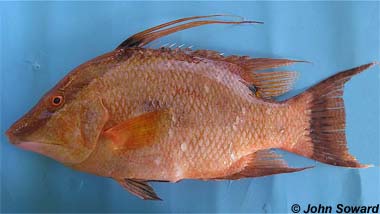
Lachnolaimus maximus
This wrasse is unusually flat and oval shaped compared to other wrasse, with red irises, and colors that change through the stages of its life. They live in small groups of one dominant male and several females, until a female grows to be a certain size and age, and then she changes to a male. The hogfish are named after the way they root around in the sandy sea floor with their pointed snout, looking for crustaceans and mollusks.
Order – Perciformes
Family – Labridae
Genus – Lachnolaimus
Species – maximus
Common Names
The common name in the English language for this fish is hogfish. Common names in other languages include bodiao-de-pluma (Portuguese), doncella de pluma (Spanish), jaqueton blanca (Spanish), labre capitaine (French), odynczyk (Polish), ornefisk (Danish), pargo gallo (Spanish), and pez perro (Spanish).
Importance to Humans
The hogfish is highly valued as a food fish, with the flesh marketed both fresh and frozen. Human consumption of this fish has been linked to ciguatera poisoning.
Conservation
Although commercial catch rates have decreased over the past seven years off the eastern coast of Florida while remaining stable in the Gulf of Mexico, there is no formal stock assessment for the hogfish. Recreational catches have also fluctuated but without any apparent trends. However, fishing pressure has reduced populations of hogfish in some areas to low levels. There have been successful attempts at raising hogfish in captivity and it is hoped that aquaculture will eventually reduce the fishing industry’s pressure on natural stocks of this fish.
> Check the status of the hogfish at the IUCN website.
The IUCN is a global union of states, governmental agencies, and non-governmental organizations in a partnership that assesses the conservation status of species.
Geographical Distribution
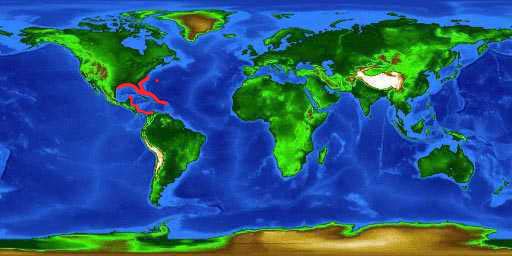
In the western Atlantic Ocean, the hogfish occurs from Bermuda and North Carolina, south through the Caribbean Sea and northern Gulf of Mexico, continuing to the north coast of South America. It is very common off Florida and the islands of the Caribbean in shallow waters. Juveniles are often found in seagrass beds in Florida Bay.
Habitat
This fish is commonly found over open bottoms and coral reefs at depths ranging from 10-100 feet (3-30m). The hogfish is often encountered in areas where gorgonians are abundant. The hogfish is widely distributed along the edges of the reef, forming small groups. It prefers locations with hard sand and rock bottoms near shallow patch reefs just inshore and offshore from the main reef structure. Larger individuals occur in the main reef area while smaller fish reside among the patch reefs.
Biology
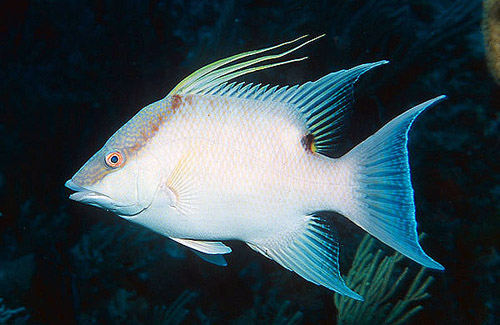
Distinctive Features
The hogfish is large with a laterally compressed body that is high and round. This is in contrast to other wrasses, which tend to be smaller and cigar-shaped. The caudal fin is slightly lunate and the first three dorsal fin spines are elongate and thickened, trailing behind the fin. The tips of the dorsal and anal fins are pointed. It uses its elongate, pig-like snout and large protrusible mouth to root around the bottom substrate for prey. It is from this snout and rooting behavior that this fish gets its common name.
Coloration
Coloration of the hogfish is variable, dependent upon age, sex, and habitat. It is generally from pearl white to mottled in brownish-red with a black spot at the rear base of the soft dorsal fin. Males tend to be more intensely colored than females. Young individuals and females are primarily pale gray, brown, or reddish brown with a paler underside. The iris is bright red in color. Males are gray-brown overall and dusky to dark from the snout through the forehead, up to the dorsal. Pectoral fins are yellow. Dark bars are located on the outer margins of the soft dorsal, anal, and caudal fins.
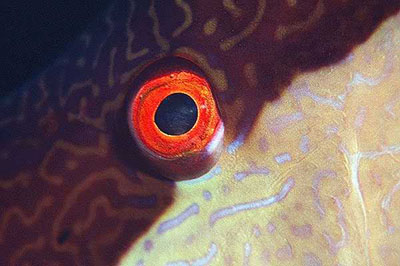
Dentition
The strong jaws contain protruding anterior canine teeth that are well adapted for crushing hard-shelled prey items such as mollusks and crabs.
Size, Age, and Growth
Hogfish reach a maximum length of 3 feet (0.91 m) total length and a maximum weight of 22 pounds (10 kg). Hogfish may live for up to 11 years.
Food Habits
Foraging by day, the hogfish is a large bottom-associated predator. Adult hogfish feed mainly on mollusks including pelecypods, gastropods, and scaphopods, but will also feed on hermit crabs, amphipods, and sea urchins, crushing its prey with strong pharyngeal jaws. During the day, this species has been observed to shove its snout into the sand in search of mollusks. Juvenile hogfish thrive on a diet of crustaceans, mollusk, and echinoderms.
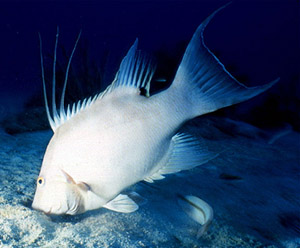
Reproduction
Hogfish are protogynous hermaphrodites. Females, upon reaching larger size and through social dominance, can transform into fully functional males. This often occurs at 3 years of age and lengths of approximately 14 inches (35.5 cm). In waters off south Florida, peak spawning occurs during the months of February and March. Hogfish schools consist of groups of females dominated by a larger male, referred to as a harem. The male guards his harem, spawning exclusively with the females within it. Spawning occurs in later afternoon and early evening. This event involves male courtship of the female, followed by a rush towards the surface. The male and female release gametes into the surrounding water where fertilization takes place. The fertilized, pelagic eggs rapidly develop into larvae, hatching approximately 24 hours after fertilization occurs. This larvae stage lasts several weeks until they grow into juveniles and settle out of the water column, onto suitable habitat. Juvenile hogfish have an oval profile and are compressed laterally. Reddish in color with faint vertical bands, they are commonly observed around seagrass beds.Predators
Predators of the hogfish include larger bony fishes as well as sharks.
Parasites
Nerocila benrosei n. sp. (Isopoda: Cymothoidae), has been recorded as an external parasite of hogfishes from the northern Bahamas.
Taxonomy
Labrus maximum (Walbaum, 1792) was the name originally used to describe the hogfish. However, it was changed by later taxonomists to the present day name of Lachnolaimus maximus (Walbaum 1792). The genus name, Lachnolaimus, is derived from the Greek “lachne, -es” meaning more covered with hair than others, and “laimos” is translated as throat.
Prepared by: Cathleen Bester